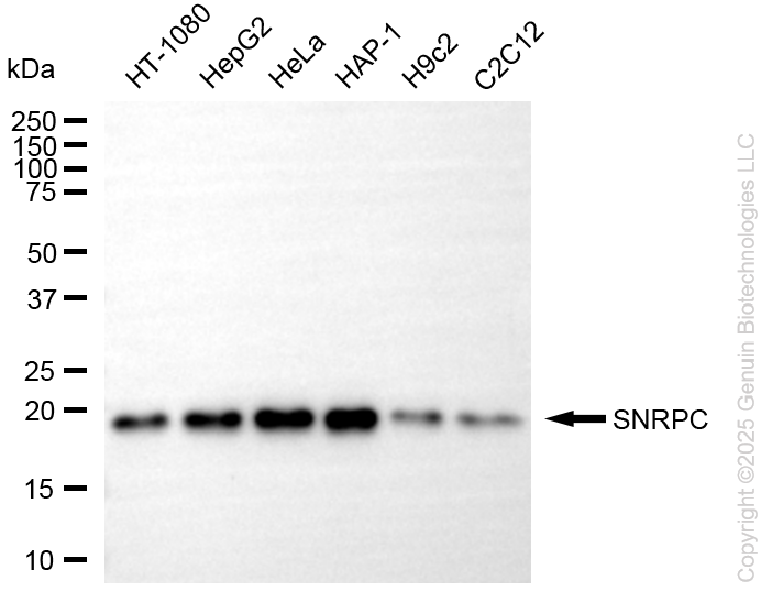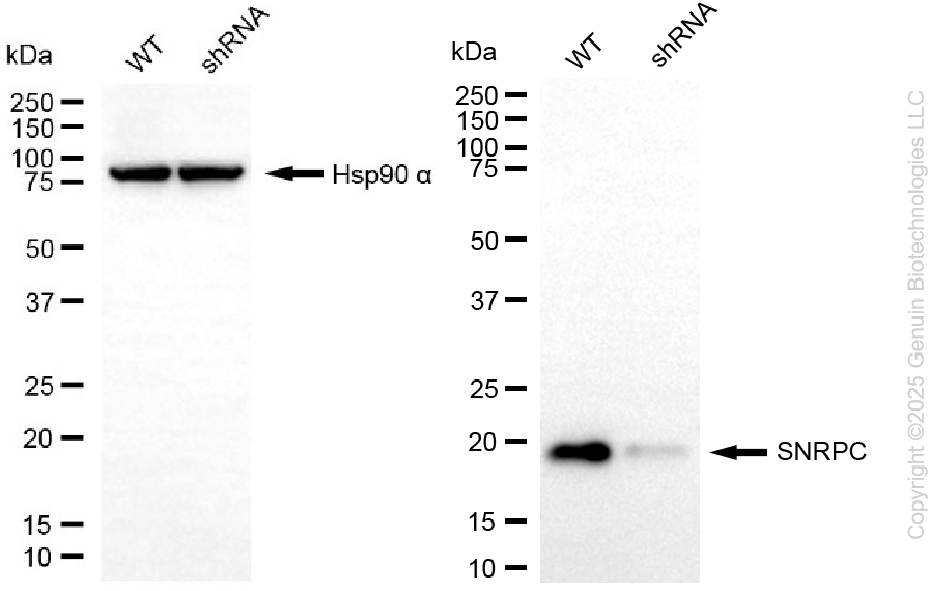KD-Validated Anti-SNRPC Rabbit Monoclonal Antibody
Rabbit monoclonal antibody
- SPECIFICATION
- CITATIONS
- PROTOCOLS
- BACKGROUND

Application
| WB |
|---|---|
| Primary Accession | P09234 |
| Reactivity | Rat, Human, Mouse |
| Clonality | Monoclonal |
| Isotype | Rabbit IgG |
| Clone Names | 25GB4570 |
| Calculated MW | Predicted, 17 kDa; observed, 19 kDa |
| Gene Name | SNRPC |
| Aliases | SNRPC; Small Nuclear Ribonucleoprotein Polypeptide C; U1-C; Yhc1; U1 Small Nuclear Ribonucleoprotein C; U1 SnRNP C; U1C; U1 Small Nuclear RNP Specific C; U1 SnRNP Protein C |
| Immunogen | A synthesized peptide derived from human SNRPC |
| Gene ID | 6631 |
|---|---|
| Other Names | U1 small nuclear ribonucleoprotein C {ECO:0000255|HAMAP-Rule:MF_03153}, U1 snRNP C {ECO:0000255|HAMAP-Rule:MF_03153}, U1-C {ECO:0000255|HAMAP-Rule:MF_03153}, U1C {ECO:0000255|HAMAP-Rule:MF_03153}, SNRPC {ECO:0000255|HAMAP-Rule:MF_03153} |
| Name | SNRPC {ECO:0000255|HAMAP-Rule:MF_03153} |
|---|---|
| Function | Component of the spliceosomal U1 snRNP, which is essential for recognition of the pre-mRNA 5' splice-site and the subsequent assembly of the spliceosome. SNRPC/U1-C is directly involved in initial 5' splice-site recognition for both constitutive and regulated alternative splicing. The interaction with the 5' splice-site seems to precede base-pairing between the pre-mRNA and the U1 snRNA. Stimulates commitment or early (E) complex formation by stabilizing the base pairing of the 5' end of the U1 snRNA and the 5' splice-site region. |
| Cellular Location | Nucleus {ECO:0000255|HAMAP-Rule:MF_03153, ECO:0000269|PubMed:2136774} |

Thousands of laboratories across the world have published research that depended on the performance of antibodies from Abcepta to advance their research. Check out links to articles that cite our products in major peer-reviewed journals, organized by research category.
info@abcepta.com, and receive a free "I Love Antibodies" mug.
Provided below are standard protocols that you may find useful for product applications.
If you have used an Abcepta product and would like to share how it has performed, please click on the "Submit Review" button and provide the requested information. Our staff will examine and post your review and contact you if needed.
If you have any additional inquiries please email technical services at tech@abcepta.com.














 Foundational characteristics of cancer include proliferation, angiogenesis, migration, evasion of apoptosis, and cellular immortality. Find key markers for these cellular processes and antibodies to detect them.
Foundational characteristics of cancer include proliferation, angiogenesis, migration, evasion of apoptosis, and cellular immortality. Find key markers for these cellular processes and antibodies to detect them. The SUMOplot™ Analysis Program predicts and scores sumoylation sites in your protein. SUMOylation is a post-translational modification involved in various cellular processes, such as nuclear-cytosolic transport, transcriptional regulation, apoptosis, protein stability, response to stress, and progression through the cell cycle.
The SUMOplot™ Analysis Program predicts and scores sumoylation sites in your protein. SUMOylation is a post-translational modification involved in various cellular processes, such as nuclear-cytosolic transport, transcriptional regulation, apoptosis, protein stability, response to stress, and progression through the cell cycle. The Autophagy Receptor Motif Plotter predicts and scores autophagy receptor binding sites in your protein. Identifying proteins connected to this pathway is critical to understanding the role of autophagy in physiological as well as pathological processes such as development, differentiation, neurodegenerative diseases, stress, infection, and cancer.
The Autophagy Receptor Motif Plotter predicts and scores autophagy receptor binding sites in your protein. Identifying proteins connected to this pathway is critical to understanding the role of autophagy in physiological as well as pathological processes such as development, differentiation, neurodegenerative diseases, stress, infection, and cancer.



